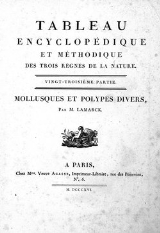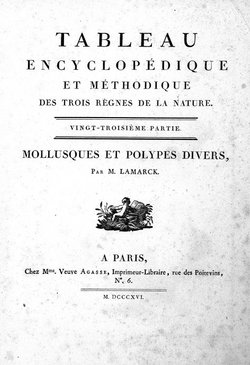
Tableau encyclopédique et méthodique
Encyclopedia
The Tableau encyclopédique et méthodique des trois regnes de la nature was an illustrated encyclopedia
of plant
s, animal
s and mineral
s, notable for including the first scientific descriptions of many species
, and for its attractive engravings. It was published in Paris
by Charles Joseph Panckoucke, from 1788 on. Although its several volumes can be considered a part of the greater Encyclopédie méthodique
, they were titled and issued separately.
 Contributors:
Contributors:
Individual prints from this work today can sell for hundreds of dollars (US) apiece.
Encyclopedia
An encyclopedia is a type of reference work, a compendium holding a summary of information from either all branches of knowledge or a particular branch of knowledge....
of plant
Plant
Plants are living organisms belonging to the kingdom Plantae. Precise definitions of the kingdom vary, but as the term is used here, plants include familiar organisms such as trees, flowers, herbs, bushes, grasses, vines, ferns, mosses, and green algae. The group is also called green plants or...
s, animal
Animal
Animals are a major group of multicellular, eukaryotic organisms of the kingdom Animalia or Metazoa. Their body plan eventually becomes fixed as they develop, although some undergo a process of metamorphosis later on in their life. Most animals are motile, meaning they can move spontaneously and...
s and mineral
Mineral
A mineral is a naturally occurring solid chemical substance formed through biogeochemical processes, having characteristic chemical composition, highly ordered atomic structure, and specific physical properties. By comparison, a rock is an aggregate of minerals and/or mineraloids and does not...
s, notable for including the first scientific descriptions of many species
Species
In biology, a species is one of the basic units of biological classification and a taxonomic rank. A species is often defined as a group of organisms capable of interbreeding and producing fertile offspring. While in many cases this definition is adequate, more precise or differing measures are...
, and for its attractive engravings. It was published in Paris
Paris
Paris is the capital and largest city in France, situated on the river Seine, in northern France, at the heart of the Île-de-France region...
by Charles Joseph Panckoucke, from 1788 on. Although its several volumes can be considered a part of the greater Encyclopédie méthodique
Encyclopédie Méthodique
The Encyclopédie méthodique par ordre des matières is a roughly 210 to 216 volumes encyclopedia that was published between 1782 and 1832 by the French publisher Charles Joseph Panckoucke, his son-in-law Henri Agasse, and the latter´s wife, Thérèse-Charlotte Agasse...
, they were titled and issued separately.

- Jean-Baptiste LamarckJean-Baptiste LamarckJean-Baptiste Pierre Antoine de Monet, Chevalier de la Marck , often known simply as Lamarck, was a French naturalist...
(plants, taxonomy) - Pierre Joseph BonnaterrePierre Joseph BonnaterreAbbé Pierre Joseph Bonnaterre was a French naturalist who contributed sections on cetaceans, mammals, birds, reptiles, amphibians, and insects to the Tableau encyclopédique et méthodique...
(cetaceans, mammals, birds, reptiles, amphibians, fish, insects) - Louis Jean Pierre VieillotLouis Jean Pierre VieillotLouis Jean Pierre Vieillot was a French ornithologist.Vieillot described a large number of birds for the first time, especially those he encountered during the time he spent in the West Indies and North America, and 26 genera established by him are still in use...
(birds, second volume) - Jean Guillaume BruguièreJean Guillaume BruguièreJean Guillaume Bruguière was a French physician, zoologist and diplomat.Bruguière was born in Montpellier.He was a doctor, connected to the University of Montpellier. His was interested in invertebrates, mostly snails ....
(invertebrates)
Individual prints from this work today can sell for hundreds of dollars (US) apiece.

